August 11th Scots Book of Days
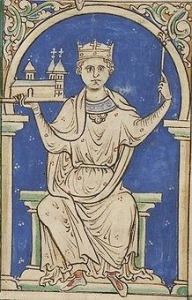 August 11 – (or 22nd) 1138 –Battle of ‘the Standard’, fought on Cutton Moor (Cowton Moor). King David marches with his nephew William son of Duncan, to Northallerton, in Yorkshire. The English attempted to negotiate a peace. Archbishop Thurstan of York raised the army, preaching that to withstand the Scots was to do God’s work. The centre of the English position was therefore marked by a mast (mounted upon a cart) bearing a pyx carrying the consecrated host and from which were flown the consecrated banners of the ministers of York, Beverley and Ripon: hence the name of the battle. This cart-mounted standard was a very northerly example of a type of standard common in contemporary Italy, where it was known as a carroccio. Scots were defeated. King David’s attendants hurried from the field, headed to Carlisle, and joined son Prince Henry. Next year 1139, Queen Maude, Stephen’s wife, and niece of King David, negotiated a peace, and the earldom of Northumberland was granted to Henry, prince of Scotland. Anderson v. 2 / p.23 gives the date as August 11, 1138. Stephen King of England, Reign 22 December 1135 – April 1141
August 11 – (or 22nd) 1138 –Battle of ‘the Standard’, fought on Cutton Moor (Cowton Moor). King David marches with his nephew William son of Duncan, to Northallerton, in Yorkshire. The English attempted to negotiate a peace. Archbishop Thurstan of York raised the army, preaching that to withstand the Scots was to do God’s work. The centre of the English position was therefore marked by a mast (mounted upon a cart) bearing a pyx carrying the consecrated host and from which were flown the consecrated banners of the ministers of York, Beverley and Ripon: hence the name of the battle. This cart-mounted standard was a very northerly example of a type of standard common in contemporary Italy, where it was known as a carroccio. Scots were defeated. King David’s attendants hurried from the field, headed to Carlisle, and joined son Prince Henry. Next year 1139, Queen Maude, Stephen’s wife, and niece of King David, negotiated a peace, and the earldom of Northumberland was granted to Henry, prince of Scotland. Anderson v. 2 / p.23 gives the date as August 11, 1138. Stephen King of England, Reign 22 December 1135 – April 1141
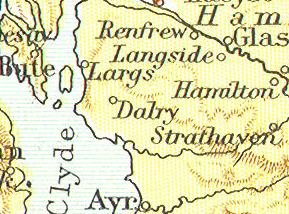 1306 Battle of Dalry, Battle of Dalrigh · fought in the summer of 1306 between the army of King Robert I of Scotland attacked and defeated John MacDougall of Lorne, kinsman of John Comyn. against the Clan MacDougall of Argyll who were allies of Clan Comyn and the English. Wikipedia.
1306 Battle of Dalry, Battle of Dalrigh · fought in the summer of 1306 between the army of King Robert I of Scotland attacked and defeated John MacDougall of Lorne, kinsman of John Comyn. against the Clan MacDougall of Argyll who were allies of Clan Comyn and the English. Wikipedia.
Dalry is north of Ayr in the middle of the map.
1332 Battle of Dupplin Moor. Domhnall (or Donald) II of Mar. Robert I Second War of Scottish Independence. The death of Robert I in 1329 left Scotland with a four-year-old king, 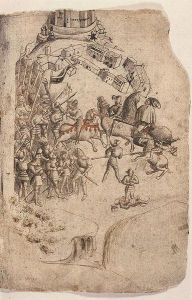 David II (1329–1371). In the early 1330s David was challenged by Edward Balliol, son of John Balliol. The rebels were known as ‘The Disinherited’, since they lost their land as a consequence of the Battle of Bannockburn. Sir Alexander Fraser of Touchfraser and Cowie died. Wikipedia.
David II (1329–1371). In the early 1330s David was challenged by Edward Balliol, son of John Balliol. The rebels were known as ‘The Disinherited’, since they lost their land as a consequence of the Battle of Bannockburn. Sir Alexander Fraser of Touchfraser and Cowie died. Wikipedia.
The earliest known depiction of the Battle of Bannockburn in 1314 from a 1440s manuscript of Walter Bower’s Scotichronicon.
1560 Latin Mass prohibited in Scotland by Parliament as Protestant faith gained the ascendancy.
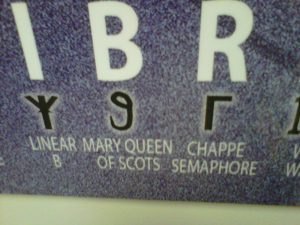 1586 Mary Queen of Scots was arrested after being implicated in the Babington Plot. B for Babington. Photo by John Choate of poster at the National Security Agency library Fort Meade Maryland showing a cipher from the cryptographic code of Mary Queen of Scots while captive in Fotheringhay castle. The English broke Mary’s code and read Mary’s letters.
1586 Mary Queen of Scots was arrested after being implicated in the Babington Plot. B for Babington. Photo by John Choate of poster at the National Security Agency library Fort Meade Maryland showing a cipher from the cryptographic code of Mary Queen of Scots while captive in Fotheringhay castle. The English broke Mary’s code and read Mary’s letters.
1660 – 11 Aug 1660 Pardon and Oblivion Act.
1701 sometime in. Failed harvest, severe famine, 5-15 percent starved to death. Last year of the seven ill years was a period of national famine in Scotland in the 1690s, by four years of failed harvests (1695, 1696 and 1698–99). The period is named after the Biblical famine in Egypt predicted by Joseph ben Jacob in the Book of Genesis. In the countryside, where the majority of the population lived, it relied on funds raised and distributed by the kirk session, usually led by the parish minister and reliant on the generosity of local landholders, particularly the local laird. The role of the minister was undermined by the results of the change of regime in the Glorious Revolution in Scotland, which meant that many episcopalian ministers had been ejected from their livings and had not been replaced by the time of the famines. In the urban settlements of the burghs there were more mechanisms that could be used to provide for the poor. In addition to the kirk sessions and general sessions of the church, there were guilds, trades’ societies and town councils. Town councils also had the ability to intervene in local grain markets in an attempt to maintain low prices in times of scarcity.[19] The impact of the famine may have been exacerbated in urban centres as the influx of new starving populations brought outbreaks of disease such as smallpox, which are evident from parish registers for the period. Wikipedia.
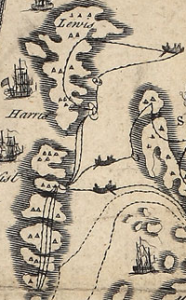 1717 Britain’s government, declaring a violation of Treaty of Utrecht, the Royal Navy intercepted and destroyed the fleet of José Antonio de Gaztañeta in the region of Cape Passaro, (near Syracuse). Spain then declared war, with Alberoni deciding to take the initiative and stir up trouble in Britain to forestall an attack on the Iberian Peninsula. War of the Quadruple Alliance
1717 Britain’s government, declaring a violation of Treaty of Utrecht, the Royal Navy intercepted and destroyed the fleet of José Antonio de Gaztañeta in the region of Cape Passaro, (near Syracuse). Spain then declared war, with Alberoni deciding to take the initiative and stir up trouble in Britain to forestall an attack on the Iberian Peninsula. War of the Quadruple Alliance
1745 Aug. 11. PRINCE CHARLES EDWARD STUART with artillery and baggage, went by sea to Kinloch-Moidart (I. 207, 292) skirting the heads of Lochnanuagh and Loch Aylort, while Clanranald’s clansmen marched by the shore (L.P. 483).
Aug. 11-17. The Prince remained at Kinloch-Moidart4 (1.292).
1919 – Andrew Carnegie died, Scottish-born American steel maker and libraryphilanthropist (b. 1835)
Utah Standard News depends on the support of readers like you.
Good Journalism requires time, expertise, passion and money. We know you appreciate the coverage here. Please help us to continue as an alternative news website by becoming a subscriber or making a donation. To learn more about our subscription options or make a donation, click here.
To Advertise on UtahStandardNews.com, please contact us at: ed@utahstandardnews.com.


Comments - No Responses to “August 11th Scots Book of Days”
Sure is empty down here...